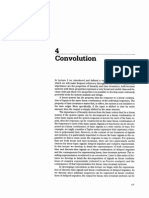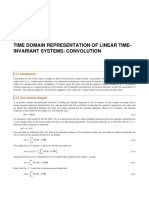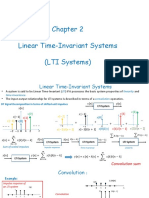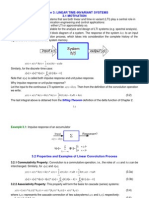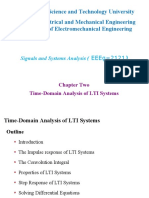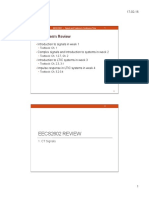0 ratings0% found this document useful (0 votes) 37 views10 pagesConvolution Integral and Properties
Signals and systems unit 2 notes are provided here.,.................................
Copyright
© © All Rights Reserved
We take content rights seriously. If you suspect this is your content,
claim it here.
Available Formats
Download as PDF or read online on Scribd
4.12 Signals and Systems
As a limit .
7 a iting case, At becomes continuous variable dt and the summation jy
integral. Therefore the representation of x(¢) becomes 7
x(0= { x(t) 6(¢-4t 4.36,
arbitrary input signal can be represen
.d shifted unit impulse functions, 1p
th
then the response of the S¥Sten,
The importance of Eq. (4.36) is that an
as a linear combination of the scaled an
response of the system to the impulse is known,
for any input signal x(t) can be obtained.
Review Questions
1) can be represented as a Linear comp,
1. Show that‘an arbitrary signal x(
‘unit impulse functions.
nation of the scaled and shifted
‘convolution Integral
initially relaxed att = 0. If the input to the S¥ste
Consider a LTI system which is ed at
is an impulse; then the output of the system iS denoted by h(t) and is calleg n
impulse response of the system. We can denote the
A(t) = T(6()) (3p
ML systerm x
a hn
Fig. 4.3 AnLTI system.
We know that any arbitrary signal x(t) can be represented as
x(t)= | x(1)6(¢—2)de an
The system output is given by
v(t) =T{x(s)] 43)�Time Domain Analysis of Continuous-Time Systems 4,13
substituting Eq. (4.38) in Eq, (4.39) yields
y)=T [Zo - ve (4.40)
For linear system
y(t) = / x(t)T(8(¢—1)]de (41)
If the response of the system due to impulse 6(1) is h(t) then the response of the
system due,to delayed impulse is
A(t,t) = T[5(t-7)] (4.42)
Substituting Eq. (4.42) in Eq, (4.41) we get
w= f x(t) h(t, t)dt (4.43)
For a time-invariant system the output due to delayed input by T is equal to de-
layed output by 7. That is
A(t,t) =A(t—1) (4.44)
Substituting Eq. (4.44) and Eq. (4.43) we get
w= fatane—ode (4.45)
This is called convolution integral, or simply convolution. The convolution of two
signal x(t) and A(t) can be represented as
Y(t) =x(t) +h(¢)
48° Properties of Convolution
Let us consider two signals x, (t) and x(t). The convolution of two signals x(t)
and x(t) is given by the equation
x(t) #x2(t) = f xi(t) xa(t—t)dt (4.46)
1, Commutative property:
Convolution obeys commutative property. That is
21 (t) #x2(t) =x2(t) #x4(1) (4.47)�414 gy
'4 Signals and Systems
Proof
We have
a@en()= [s(2)n0—aar
Let t-t=p
then —dt=dp
Substituting these values in Eq. (4.48) we get
24 (t)#x2(t) = - / 22(p) x(t p)dp
7 [20)n(t- pap
=nien()
>. [n@n() =n()en
2. Distributive property:
21(t)* a(t) +230] =21(1) +2214) +211) +x5(4)
3. Associative property:
x(t) [x2(¢) #33(¢)] = b(t) #x2(0)] #x3(1)
4, Shift property:
If x(t) *x2(t) =2(¢)
then
X(t) *x2(t-T) =2(¢-T)
Proof
n(Q*n(-7) = [at)ne-r-nae :
=2x(t-T)�Time Domain Analysis of Continuous-Time Systems 4.15
Similarly
ai(t=T) #x,(0) =2(1- 17) (4.54)
and xy (t-T))an(t-) =2(t- 1 - B) (4.55)
5, Convolution with an impulse:
Convolution of a signal x(t) with a unit impulse is the signal x(t) it self.
That is
x(t)+8(0) =x(¢) (4.56)
Proof
= 0 otherwise
x)#8() = / (2)80-Hae 8(t-1) =1fort=t
x)
6. Convolution with shifted impulse
Convolution of a signal x(t) = shifted impulse 5(¢ —%) is equal to
x(t—f). That is
x(* a to) =x(t-t0) (457)
3(0)+8(t-6) = | x(1)5(t-1-t9) dt
=x(1) [retry =2(t-f0)
7. Convolution with unit step
Convolution of a signal x(t) with unit step signal u(¢) is given by
t
x(t)#u(t) = J x(t) dt (4.58)�4.16 Signals and Systems
Proof
x(t) #u(1) = I x(t)ut—1)4t
!
= [xa arate ifort s
8. Convolution with shifted unit step |
Convolution of a signal x(¢) with shifted unit step signal is given by
fo
x(t) «u(t 40) = [xe 4.
9. Width property:
Let the duration x; (#) and.x2 (#) are T; and Th respectively. Then the duratiog
of the signal obtained by ‘convolving x1(t) and x2(0) is T+B.
Review Questions
1. Define convolution integral.
2, Explain in detail about the properties of convo!
3. Show that
(a) x(t) ¥5(0) =a(4)
() x(4)#8(t- = x(t-to)
(©) x(s)eu(t) = J x(t)dt
lution.
Impulse Response of Interconnected Systems
4.6.1 Systems in parallel
Consider two LTI systems with impulse responses My (t) and ha(t) connect
parallel as shown in Fig. 4.4.
The output of system |
vit) =x) #hi(t)�Time Domain Analysis of Continuous-Time Systems 4.17
yi(t)
{ono |
o He
hw
ya)
‘system 2
Fig. 4.4 Parallel connection of continuous - time systems.
‘The output of system 2
wile) = xl) hale) (461)
‘The overall output
v(t) =yi(t) +yr(¢) (4.62)
= x(t) *hi(e) +24) #2)
= fx ahi tonart [te ing(t — t)d
= f x(t) (n(t—1) + hn(t— a) dt
= fo ht—t)dt
=x() *h(t)
where h(t) is given by
A(t) = Ay(t) + Ao(t) (4.63)
« That is the impulse response of two systems connected in parailel is sum of the
individual impulse responses.
4.6.2 Systems in cascade
Let us consider two systems with impulse responses hy (t) and z(t) connected in
cascade as shown in Fig. 4.5.
The output of system 1 is
a(t) = x(t) + hi (2)
= / x(t)iy(t— dt (4.64)�4.18 Signals and Systems
xit) we ‘ oh, * bt)
7 nC)
System | ‘system 2 yume.
Fig. 45 Cascade connection of continuous time
The output of system 2 is
y(m) = yr (em) hal)
« [one «hn(m)
= / Jaome-omser (465)
Let k-t=4
won) = f x0) faster ayaa at
= f x(yamn— tat : (466
= x(m)+A(rm)
where
aim) = faladin—aea aa
= hn(m) #alm) 463}
‘Therefore, the impulse response of two systems connected in series is equal to te
convolution of the individual responses.
Review Questions
1. Show that the impulse of two systems connected in
convolution of individual responses.
2, ‘Show that the impulse response of two syste!
‘equal to the sum of individual responses.
series is equal to the
mm connected in parallel is�Time Domain Analysis of Continuous-Time Systems 4.19
4. .7_easuality
In section (3.10) we introduced the causality condition on impulse response for
discrete time systems. On the similar lines we can find that for.a causal LTT
system, the impulse response h(r) must be zero fort < 0.
Consider a continuous-time LTT system whose output y(?) can be obtained
using convolution integral given by
y(t) = / A(t)x(t—t)dt (4.69)
From Eq. (4.69) we can find that the output y(r) depends on past, present and
future values of input. If t > 0, the output depends on present and past values of
input. If t < 0, then output depends on future values of input. But for a causal
system the output depends only on present and past values of input which implies
that h(t) =0 for t <0.. Therefore the limits of the integral can be changed as
follows.
y= [ A(t)x(t—t)dt (4.20)
0
‘An LTI continuous system is causal if and only if its impulse. response is
zero for negative values of t.
Ifa causal signal is applied to a non-causal system, then
y(t) = f x(t)A(t= tat
0
;
= | A(tyx(t—1)de (a7)
If a causal signal is applied to a causal system, then
t
vt) = | x()Mt—1)de
0
‘
= J A(a)x(t—t)dt (472)
3�-4.20 - Signals and Systems
Review question .
=o fort <
ia causal system the impulse h(t) =0 for
Solved Problem 4.3 Find the convolution of xi(¢) and x(t) for the following
signals :
@ uQ=euy: n= e Mult)
Gi) (Haul); 2) = u(t)
Git) n(Q=uQ; a) ="
(iv) 2x1(t) = sintu(t); x(t) =H)
Solution:
(i) Given x(t) = etu(t), 2
We know n()en(t) = | ay (t)xx(t— 1)4T
A signal x(f) is said to be causal if x(t) = Ofort <0.
Inthis case both signals x1 (¢) and x)(t) are causal. Therefore using Eq. (47,
we have ,
si(d)asa(t) = f x(ealt~ tat
0
z fen elder
0
1
aot | eltge
oO
et "
= —(a—b)t
=(a—b)°
0
e401]
boa for 1>0�Time Domain Analysis of Continuous-Time Systems 4.21
+ Gi) Given x (1) = u(t) and x2(¢) = u(r)
Both signals are causal. Therefore the convolution of x1(¢) and-x2(¢) is
given by
x(x) = fi) x(t —t)dt
+ u(t)= fort >0
u(t—t)=1 fort >t
Gi) i() seus); 22) = u(r)
Both signals are causal. Therefore
'
nent) = [meal or
2
z for t2>0
a
t
2
[r= 7
0
2
sue)
(iv) x1(t) =sintu(t); — x2(t) = u(t)
f sint dt
a
"
ai(Qen(e
= —cost
=(l-cost) fore >0
lo
= (1—cosr)u(t)












